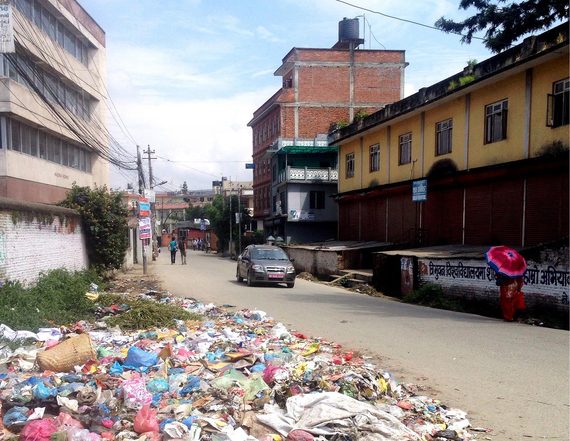There's no doubt that trash is an eyesore in Kathmandu.
I passed by this scenic example of my neighborhood trash piles today as I was out buying groceries. All over Kathmandu Valley you can find mounds of these colorful little bundles of plastic by the side of roads, streams and paths. Tongues carefully knitted together, the fate of the bags is usually to end up ripped open by dogs and rats or flattened by passing motorists. Inevitably the contents -- banana peels, blister packs, coffee grinds, leftover rice, meat fat -- oozes out into a stinking mess.
At first I was thoroughly disgusted by it all, but after a while I've grown to really like these piles. Basically everyone just puts their trash into a little bag and chucks it into the corner of the road. During the day trash pickers comb through the mound, dogs pick at the leftovers, and the pile grows and grows. At night city service teams come by and take it all away. And the next day the cycle starts all over again.
It's a dirty system, and ugly, and possibly even dangerous. And, oh how I hate how prevalent plastic shopping bags are in Nepal and throughout all of Asia.
So what do I like about Nepal's iconic neighborhood trash piles?
Well, for starters I like that Nepalis mostly toss out organic waste, rather than huge amounts of western style packaging. Yes, the blister packs and plastic gum wrappers aren't going to compost any time soon, but the whole system, shaky as it may be, would completely topple if Nepalis were chucking out old fridges, flat screen TV boxes package, stained mattresses, and all the other big items that clog up Western landfills and clutter the shoulders of urban alleys in Oakland, Houston, and Phoenix. Nepali's can't afford that stuff, for now, and anyway they're pretty good at maintaining items in order to get long life out of them.
I also like that the piles make it easy for trash pickers to harvest what they can find, and for Nepal's thousands of stray dogs to get something to eat. Often, for example, when I pass by a large pile near Patan's Mangal Bazaar at night, there might be half a dozen people and a whole pack of industrious dogs going through the pile. Now, what percentage of the waste is actually recycled in these ways I doubt anyone knows, but it's clear that much of it is put back to use before it even goes to the landfill.
Finally, though, I like that Nepal's waste problem is out in the open and right in your face. One of the things that brand us as humans is our ability to produce trash waste. In Nepal this aspect of who we are is unavoidable, and it forces me to second guess, on a daily basis, many of the choices I might otherwise make as a consumer -- conscious one or not.
It's a big change from how trash is handled back in my home in the western United States. There I never have to see my neighbors' trash, never have to avoid stepping into it, never have to wonder how long it will take to break down in the environment, and never have to wonder if someone will get sick because of it. This last blight, in particular, may in fact be happening all over North America right now despite all the efforts that communities undertake in order to make waste management seem sanitary.
Nepal, by contrast, was slow to learn how to manage solid waste, and it wasn't really until the 1970s and 1980s that modern landfills were created to house the remains of the country's booming modernization, urban migration, and increasing consumption. In the 1990s, as the country fell into civil war with Maoists, graft, poor management and general ineptitude clogged up the operations at many of the nation's landfills, leading to leakage, contamination and, often, uncollected garbage -- especially during Nepal's many holidays.
Making things worse, a very common approach to dealing with trash in Nepal is to leave it beside the many waterways that course through the Himalayan valleys that criss-cross the country. Although this problem is getting better, it's common that the first rains from the monsoon season will wash many tons of collected trash out of the canyons and down into the lowlands.
So the country has a pretty serious waste management problem. But I'd like to believe that with time and distance from the 1996-2006 insurgency, this issue, and others, will be ironed out and given the attentions -- and solutions -- it deserves. Already, work is underway to make plastic bags a thing of the past in Kathmandu Valley. Who knows what's next.
